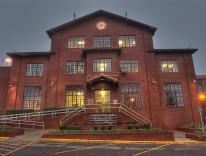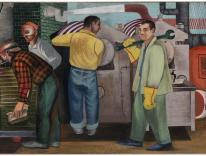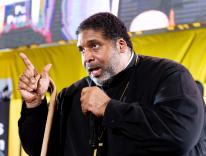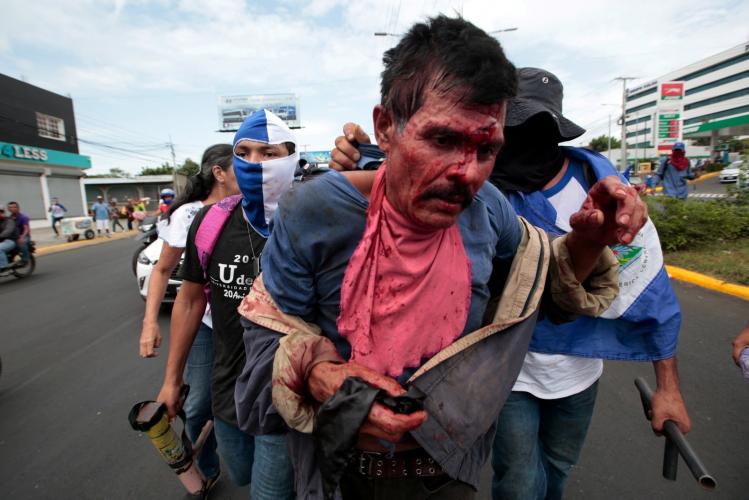
On July 19, 1979, masses of the Nicaraguan people marched victorious into Managua, having toppled the regime of Anastasio Somoza Debayle, a dictator who had enjoyed the support of the United States. Since coming to power in 1936, the Somoza family had treated Nicaragua as a personal bursary, their government operating on the principles of a criminal syndicate. The cramped dungeons of Tiscapa, right beneath the presidential residence, were filled with political prisoners, subject to rape and beatings. In the mid-1970s, a special anti-terrorism squad patrolled the poorer barrios, snatching young activists. It shackled their hands behind their backs and tossed them down a high Managua hillside to their deaths. But after years of organizing, followed by two years of fighting, the Nicaraguan people were finally rid of the Somoza dynasty. Standing in the plaza between the National Palace and the Catedral de Santiago, whose wide aisles and embracing side chapels had provided shelter when students fled the brutality of Somoza’s police in the early years of protest, they declared the birth of a new nation.
The setting wasn’t incidental. Throughout Latin America the architecture and infrastructure of the Catholic Church has reflected its tight affiliation to state power since the days of Cortés and the Doctrine of Discovery. In Latin America the Catholic Church, landowners, and the military worked together for four hundred years to establish and maintain a system that occasionally shifted in detail but never in principle. A tiny elite held power. A pervasive military defended it. An acquiescent church sanctified it, promising the people succor for their suffering—but only after they died. All through these centuries, rebellions flared and were extinguished by this triumvirate. Somoza’s father, Anastasio Somoza García, declared the Virgin Mary patron of the nation in 1950; the church hosted a Eucharistic congress in celebration. When the Maryknoll sisters arrived in Nicaragua in 1946 to establish a school and a health clinic in a remote mining town, they met first with the Somoza family to ask for its permission. The superior of the sisters’ mission promised to stay out of politics. She said they’d be no trouble. (To their credit, they later proved to be a tremendous amount of trouble.) When Anastasio Somoza Debayle was installed as president in 1967, the Catholic bishops were all on board.
But by the time those jubilant crowds gathered in between the palace and the cathedral, much of the Nicaraguan church had changed sides. In little more than a decade, many of the laity and lower clergy had gone from understanding themselves as guardians of the established order to becoming keepers of the conscience of the revolution. Among those marching into the center of Managua for mass demonstrations were cadres of Catholic faithful, trained and radicalized by Catholic social teachings; members of base Christian communities that modeled themselves on the early church; nuns who’d served as medics to rebels; priests who’d written manifestos articulating a Christian response to tyranny. The Sandinista revolution couldn’t have happened without the Catholic Church. But this church was very different from the one that had propped up landowners and helped keep down the masses for centuries. This one was led from below, diffuse, democratic, and notably female. Forty years later, after so many compounding tragedies and movements that now smell like spoilt milk, it is difficult for us to appreciate the incandescent hope that animated that triumph over dictatorship.
The Christian side of the movement had emerged from market women and subsistence farmers, Catholics who’d studied the Bible and found in it a story of their own liberation, both eternal and temporal. Contrary to the expedient tale they’d long been told, their suffering was not ordained by God. A reading of the gospels and the church’s social teachings, informed by dialogue steeped in their own experience of poverty, state repression, torture, and injustice, led hundreds of thousands of Nicaraguans to conclude that their faith required more of them than waiting patiently for the compensations of the world to come. It required them to participate in their own liberation in this world, to actively build the kingdom of God. By 1977 even the country’s bishops had been converted. That year they issued a letter that emphasized the duty of all Christians to be engaged in the political and social questions of the nation.
When it finally came, the July 1979 uprising carried a distinctly arrival-in-Jerusalem feel. During the last days of the insurrection, the faithful read the book of Revelation while bombs fell. The time was coming, they told themselves. A new order was being born.
After Somoza fled, the small Christian communities, called base communities, threw themselves into the work of establishing a new country. Church for many became dedication to the revolution. Fernando Cardenal, SJ, became minister of education in the new government and launched a highly successful literacy initiative that sent young people into the countryside to teach adults who’d never been in school how to read. His brother, Fr. Ernesto Cardenal, an acolyte of Thomas Merton and a poet, became minister of culture. Maryknoll Fr. Miguel d’Escoto was foreign minister, representing the fledgling government internationally. Fr. Edgard Parrales was ambassador to the Organization of American States. But don’t let this list of clergymen mislead you. The church was the laity. They supported the revolution because they were its parent.
That was all forty long years ago. The arrival-in-Jerusalem atmosphere soon gave way to a Gethsemane feeling, to a sense of betrayal and increasing disappointment. In the decades since the revolution, the broad, bottom-up, truly popular revolution has congealed into the person of one decidedly compromised man: Daniel Ortega. Revolt against him and his wife, Rosario Murillo, emerged in April 2018 like some dented echo of the 1970s. Singing in the streets. Youth and poor people marching. Once again, a brutal regime filled Tiscapa with political prisoners, and government troops quashed protests with billy clubs, tear gas, and bullets. On April 18, police and military raided the Jesuit University of Central America and arbitrarily arrested scores of students. At a protest on April 21, students fled into the new Metropolitan Cathedral, sheltering in its wide aisles and side chapels from the very government their parents had struggled to birth. Now the roles of the popular church and the hierarchy were reversed: the bishops supported the protestors unequivocally, while the church of the base Christian communities and many of the laity was divided. When, in the early seventies, protestors sought shelter from Somoza’s guards in churches, the bishops described it as a “desecration.” Last year Managua Auxiliary Bishop Silvio José Báez told protesters, “I want to thank you in the name of the church, because you are our country’s moral reserve.” But other parts of the church remain loyal to the Ortega government, their access to power and prestige making them as acquiescent as the conquistador bishops once were.
The marches and street protests of the past year were consciously referential. The kids sang the folk songs of their parents and grandparents, and spoke of the unity of the people. Their demands were hard to argue against, and they cultivated the same language of love and moral purity as their forebears. But among the opposition were forces that had been working to dismantle the revolution from the moment it emerged. The U.S.-trained Contra soldiers who’d buried their weapons in 1990 spoke darkly of reactivating. The moneyed Somoza allies who’d fled in 1979 to South Florida—that sunny redoubt of Latin American revanchists—were only too ready to marshal their influence against Ortega. This occasioned a “Through the Looking-Glass” atmosphere, a certain moral dizziness, amplified by social media, doctored videos, allegations, and counter-allegations. What side were defenders of human rights supposed to be on this time? To many observers, it wasn’t clear. There were rifts in the robust U.S. solidarity movement: recriminations, allegations of naïveté and counter-allegations of stoogedom.
It’s hard to know, reading U.S. media, precisely which end is up. I wrote a book centered on the role Christians played in the Nicaraguan revolution. When I dived into the microfilm to read contemporary U.S. press accounts of the 1970s after interviewing central actors in the revolution and reading diaries and letters of those who lived through the era, I learned that the story that gets told here is remarkably different from the one that gets told in the barrios of Managua. There’s always another side or two to the story. That said, surely we know tyranny when we see it.
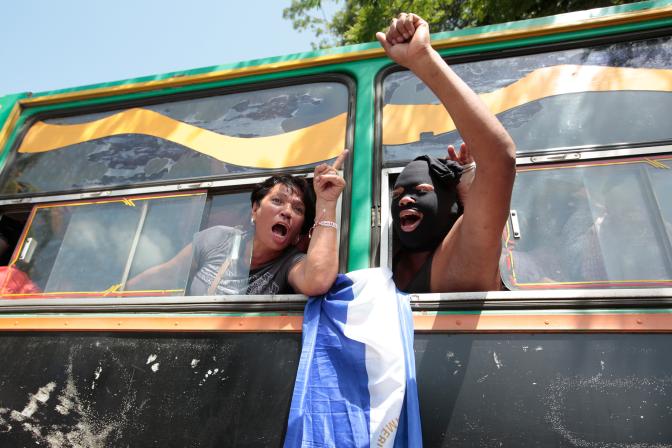
The proximate cause of the 2018 protests was a proposed cut to social-security payments, goaded by the International Monetary Fund. But by mid-April, indigenous and environmental activists had been rallying for weeks over the government’s failure to contain a fire in a wildlife conservation area on the nation’s Atlantic Coast. These protestors believed that Ortega’s Sandinista government was intentionally permitting the refuge to burn as part of a plan to make the land available for foreign investors and for a Chinese-built canal meant to rival the one in Panama. (The charge was not implausible: Nicaragua was rapidly deforested in the 2000s in order to create grazing land for Venezuelan cattle.) Small farmers on the Atlantic coast had been complaining for years about their land being taken for the canal—and about receiving little or no compensation for it.
On May 27 of last year, masked men the Jesuits believed to be government soldiers attacked the University of Central America in Managua, firing a mortar toward campus security guards. José Alberto “Chepe” Idiáquez, SJ, the rector of UCA, condemned that attack as an act of intimidation. Then on May 30, Nicaragua’s Mother’s Day, a protest march commemorating those who had been killed since the start of the unrest in April was violently disrupted. As protestors passed UCA, they heard gunshots. In a confused scramble, they fled the police, surging onto the campus after Idiáquez ordered the gates opened. For the next several hours groups of protestors hunkered down on campus. By the end of the day, sixteen protestors were dead and two hundred injured. The summer of 2018 wore on in barricades and skirmishes in Managua and other cities.
These have continued sporadically into 2019, though they are now much reduced in scale. On September 9 of this year, approximately twenty UCA students held a protest on campus, decrying the government’s withdrawal of its usual public funding to the university. Hundreds of heavily armed police surrounded the campus. “The UCA is a goal or a target for the government because our students are protesting on different days,” Idíaquez explained in a phone interview. Worse than the intimidation in the city is what Idíaquez believes is a steady campaign of assassination in rural areas, where he says one or two campesino leaders of the opposition to Ortega are killed each day, a hollowing out of resistance. “This government is willing to continue in power even if we become a cemetery,” he said.
The Nicaraguan bishops’ conference has condemned the repression and violence and is expected to issue a new pastoral letter in mid-September. The Jesuits have been at the forefront of opposition and many priests and nuns see themselves in the familiar role of accompanying those oppressed by a brutal government. “There exists a strong persecution against the Catholic Church. I am not saying against the bishops, but against the whole church,” Idíaquez said.
The Inter-American Commission on Human Rights visited Nicaragua in May 2018 and issued a report the next month condemning the Ortega government for arbitrary police actions against protestors, denial of medical treatment, reliance on paramilitary groups separate from the Nicaraguan security services, and the cruel and degrading treatment of prisoners, including torture. In October 2018, Amnesty International issued a report called “Instilling Terror: From Lethal Force to Persecution in Nicaragua,” condemning the torture and indefinite detention of more than five hundred political prisoners. The International Press Association issued two warnings about press freedom in the country. By fall the streets of Managua were heavily patrolled, students entering the National Autonomous University were routinely searched, protest was banned, and, incredibly, the Nicaraguan flag, which the protestors had cannily adopted as their emblem, was outlawed.
According to Amnesty International and the InterAmerican Commission on Human Rights’ Special Monitoring Mechanism for Nicaragua, today the number of dead stands at more than three hundred, including twenty police officers the government says were killed by protestors. More than a hundred people are still imprisoned, and 83,000 are in exile, mostly in neighboring Costa Rica. Bishop Báez left for Rome in late April 2019, amid increasing threats against his life, and has yet to return, though he still issues statements on social media. Ortega’s denunciations of the Jesuits as coup-mongers and Svengalis were another uncanny historical echo, conjuring memories of the 1989 assassination of the Jesuits and Elba and Celina Ramos at the University of Central America in El Salvador.
Soon after becoming rector of the Managua UCA in 2014, Idíaquez recognized that the Ortega government was trying to control discourse in the university. “I would invite people to speak about the canal, about the land seizures, and it was prohibited to do that. I wanted to invite people to think, but Murillo and Ortega would say through their allies that this is an act against them.”
Idíaquez is not surprised by the corruption and brutality of the Ortega regime and feels no sorrow in resisting it. He never supported the revolution. “I was very critical of the revolution. I saw many things that were not right. To me this is not a surprise that it went like this,” he said. He is dismissive of the Catholics who supported the revolution, saying they were part of a manipulation of religion—and attributes the continued support for Ortega in some quarters to bribery and manipulation.
Beginning in May 2018, Catholic bishops and Jesuits presented themselves as mediators, eager to convene a national dialogue between the government and protestors. But at the same time, the church hierarchy condemned the Ortega government and encouraged the opposition. Their efforts at dialogue did not get very far, and Ortega, who appeared weakened in the summer of 2018, now shows no signs of leaving office. He declared the national dialogue effort “complete” months ago.
When Somoza adopted similarly fierce anti-dissent laws in 1974 after a spectacular and embarrassing Sandinista raid on a cabinet member’s Christmas party, the restrictions had the effect of radicalizing the population. Martial law created militants. This time the crackdown has been more successful. The Nicaraguan opposition seems broken, disillusioned, and fearful. Ortega appears to believe he can now afford magnanimous gestures. In June his government released scores of political prisoners and announced an amnesty for anyone accused of a crime during last year’s protests. Members of the opposition welcomed this news, but they also knew it was a sign that the government no longer regarded them as a threat. And the amnesty meant there would be no accountability for crimes, torture, and murders committed by the security forces.
The protests that began in April 2018 were the boiling-over of years of discontent with the Ortega regime. Many of the president’s close allies and one-time comrades withdrew their support for him and the leadership of the Sandinista party as early as the 1990s, calling out the government’s financial corruption, increasing authoritarianism, and personal enrichment at the expense of the nation’s poor. Fernando Cardenal, SJ—who in 1984 accepted the Vatican’s suspension of his priesthood rather than renounce his role in the Sandinista Party and his post as minister of education—left the Sandinistas in 1995, saying he could not in good conscience remain a member of a party he believed was abandoning the ideals of 1979. His brother Ernesto also renounced Ortega and the cronyism of the party. But not everyone agreed with them. Fr. Miguel d’Escoto, a frequent face of the Sandinista movement in the United States, remained loyal both to the party and to Ortega. Like the Cardenal brothers, d’Escoto was stripped of his priestly faculties by Pope John Paul II when he refused to abandon his political office in the 1980s. (Pope Francis restored them shortly before d’Escoto’s death in 2017.) As Ortega gathered more and more power to himself and grew more venal, d’Escoto was honored and promoted as a symbol of the revolution’s days of radical hope and possibility. But by then, d’Escoto was deeply compromised, a tool of a regime whose conscience he could have pricked—but didn’t.
Elements of the institutional church offered tentative support for the new Sandinista government in its first years, but that support was soon withdrawn. The hierarchy, already wary of a government of self-described Marxists, were cowed and then reorganized by the aggressive Cold War–maneuvering of Pope John Paul II, who saw little distinction between the Sandinistas and the Soviet Union. It was during this period that the Nicaraguan church effectively split, and it’s remained split ever since. A priest who has been intimately involved with base Christian communities and other rural Catholic groups since before the revolution told me that the conflict of the past year has ruptured decades-long friendships formed in shared struggle and deep idealism. Assemblies that hung together during the Contra War, who worked beside each other to protect the coffee harvest in those lean years, who hosted tens of thousands of sympathetic U.S. church visitors—part of a strategic and highly effective propaganda campaign—are now silent and divided. On one side are those who believe Ortega has degenerated into just another dictator, like the Somozas; on the other are those who believe that opposition to Ortega can only help the old forces of oppression.
While U.S. news coverage is largely focused on opposition to the government—including glowing profiles of the brave, armed freedom fighters massed in Costa Rica that could have been published in 1983—there remain many government loyalists in Managua and elsewhere. For them, U.S. sympathy for the opposition only confirms that the revolt was a coup attempt organized by Washington. This is hardly a farfetched belief, given U.S. involvement in the region. Historians disagree about whether FDR was referring to the older Somoza or to Rafael Trujillo of the Dominican Republic when he said, “He’s a son of a bitch, but he’s our son of a bitch.” What is clear is that the United States has backed—and sometimes even trained—many SOBs in Latin America. In 2009, the United States helped overthrow a government unfriendly to U.S. energy interests in Honduras. Elliott Abrams, the neocon bad penny of U.S. foreign policy who was convicted for his role in the conspiracy to sell weapons to Ayatollah Khomeini’s Iran in order to raise funds for the Contras, is now a special envoy to the region. (The elaborate subterfuge of the Iran Contra Affair was necessary because Congress had explicitly prohibited funding to the Contras as early as 1982, in response to the viciousness of the Contras’ assaults on the Nicaraguan people.) One can forgive weary Nicaraguans their well-earned skepticism of U.S. interests.
The Nicaraguan revolution was many things. To many U.S. Catholics it was understood as a revolution animated by liberation theology. To the Latin American left it was the continuation of the Cuban Revolution, a Marxist victory over a client-state regime that enriched itself on the misery of its people. To U.S. conservatives and anti-Communists, it was second in a line of dominoes much closer than Southeast Asia, their alarm leading to a decade of Faustian support for the far more vicious war in El Salvador. To casual admirers and romantics, it was the revolution of photogenic and luxuriantly mustachioed rebels, the poetry of Rubén Darío and the music of the Clash. It propelled a hundred dissertations and a network of solidarity organizations in the United States, many Catholic and Jesuit-affiliated.
But the heady days of the revolution have been followed by a long hangover, as supporters and sympathizers of the Sandinistas have witnessed the betrayal of the movement by some of its leaders, including Daniel Ortega himself. It’s true that the Sandinista movement was fed and propelled to success by many Catholics and adherents of liberation theology. But Ortega himself did not emerge from that wing of the movement. He was a Leninist and an atheist. And most members of the Sandinista elite who had been formed in base Christian communities peeled off from the Ortega regime many years ago, when it began showing dictatorial tendencies, operating more like a club than a movement for justice. At around the same time Ortega began cooperating with the neoliberal economic order, seeking international investment. Prison for dissidents, green lights for capital: this was supposed to be the formula for right-wing autocrats like Pinochet, not revolutionaries like Ortega. But power has a strange way of distorting ideology.
In 1998, Ortega’s stepdaughter, Zoilamérica Narváez, whom he’d raised from infancy, brought criminal charges against him, accusing him of years of sexual abuse and rape. She claimed Ortega had begun sexually molesting her in 1978, when she was eleven. Beginning when she was fifteen, she claims, he raped her frequently, sometimes pulling her into hotel closets on overseas trips because he feared his hotel rooms were bugged by the CIA. Narváez says Ortega told her it was her revolutionary duty to allow him to have sex with her. She says he told her he needed her sacrifice to keep his head clear for the great work to which he was called. The alleged abuse continued into adulthood and after she married. She brought charges in the Nicaraguan court system, but Ortega’s position at the time in the National Assembly gave him immunity from prosecution and the legislature never revoked that immunity. Narváez brought her case to the InterAmerican Commission on Human Rights in 1999 but eventually withdrew it, according to the records of the commission. Her accusations against Ortega were never adjudicated.
In its allegation of a twisted abuse of trusted authority and the sacralizing of sexual violation, Narváez’s story is painfully familiar: it sounds like a clergy sex-abuse case. The haste to discredit Narváez on the part of the party faithful reminds one of how too many Catholics responded to the first wave of accusations about clerical abuse. Loyalists to the party dismissed her allegations as a set-up by political enemies who were said to be manipulating a troubled young woman. Siding with her husband against her daughter, Rosario Murillo has steadily exerted more influence and control over what remains of the Sandinista movement.
Meanwhile, as many of its old allies abandoned the Sandinista party—and formed a variety of alternative movements left and right—the institutional church grew closer to the sclerotic strongman. In 2006 Bishop Miguel Obando y Bravo, by then retired but still wielding tremendous influence because he was a cardinal, became something of a private chaplain to Ortega and Murillo. That year Ortega, having been out of office for sixteen years, ran an election campaign based on a dramatic public embrace of Catholicism. Ortega and Murillo, who had been together for decades and had six children, were married in a Catholic ceremony, with Bishop Obando officiating. Back in office, Ortega consolidated his support with the Catholic hierarchy by banning abortion in all cases. (It had previously been restricted but legal in certain cases.) Bishop Obando had been very critical of the Sandinista government back when it had legions of idealistic adherents. He was sometimes called the Contra bishop for his closeness to the counter-insurgency army made up of Somoza’s former National Police and trained by the United States at bases in Honduras. He had traveled to Washington D.C. to lobby Congress for U.S. intervention in Nicaragua. And he had zealously preached against the Sandinistas in the electoral campaign of 1990, which the Sandinistas lost. So his sudden embrace of a diminished and compromised Ortega struck many as grubby—another case in a long history of episcopal opportunism or evidence of some monumental blackmail.Whatever the reason, it was effective.
Hope has died many times after the revolution and appeared to recede again as last year’s protests flickered and faded. Because the revolution had been so bottom-up and broad, its embodiment in a single man is a tragedy. The revolution of 1979 was never just Daniel Ortega; it was never even just the Sandinista Front for National Liberation. It was 100,000 Nicaraguans claiming a mantle of idealism and refusing to accept the way things had always been. Nicaragua has held the imagination of so many U.S. Catholics not just because of its image as a country of poet rebels, or even because it promised a new kind of society, with increased literacy, improved public health, and the emancipation of women—a nation that would disregard the demands of the Global North and go its own way. It held our imagination because it seemed to offer a new kind of church, one not oriented to the preservation of wealth and privilege but to justice and honest, intimate community.
That we now say “the church” is resisting Ortega, when we mean that the bishops and the head of a university are resisting him, is a sad thing. It misses the point of what happened in the Nicaraguan church forty years ago. The laity led. It was they who developed a new—but also very old—way of being church. Their work made possible first the overthrow of a dictator and then the establishment of a new country. Now parts of that popular church are playing it safe, binding themselves so close to temporal power that they cannot see its glaring failures. It isn’t only willful blindness, though, that keeps them from acknowledging Ortega’s failures; it’s also resentment against their old enemies, many of whom deserve that resentment. The popular church could advocate for a true return to the values that animated so many in 1979 and that today’s young dissidents have taken up: an economy that serves the poor, human rights, dignified work, not only free elections, but a consultative democracy, where the people have a say in the decisions that will affect them. The institutional church could be the conscience of this opposition, making sure it isn’t hijacked by the Organization of American States, the U.S. government, or the old enemies of the revolution. Both the institutional and the popular church need to reclaim their role as the conscience of Nicaragua, not speaking for any party or falling behind dubious allies, but nurturing the hope that drove them into that open plaza between church and state forty years ago.
Please email comments to [email protected] and join the conversation on our Facebook page.
Previous Story
Inescapable Influence
Next Story
Grace over Greed
